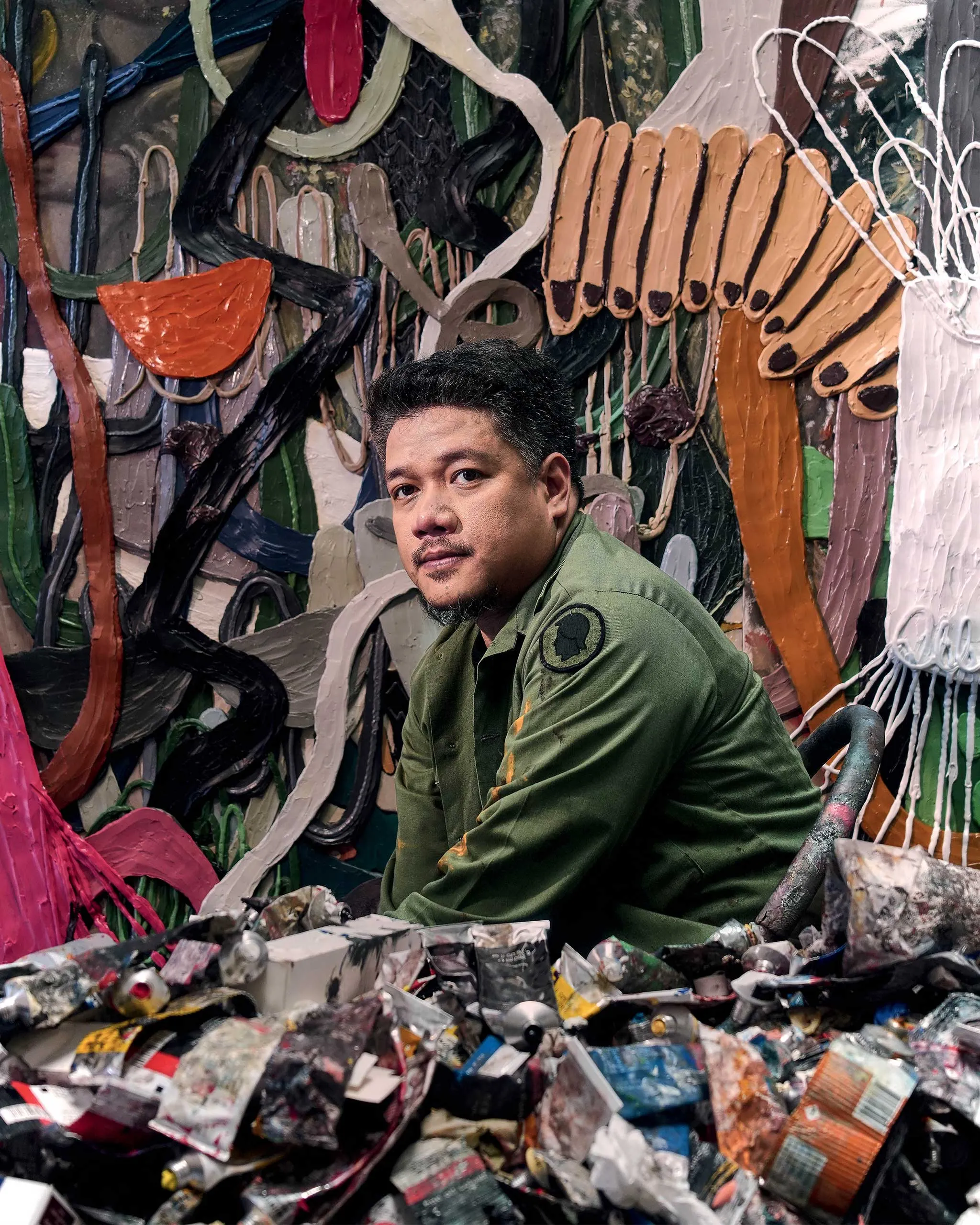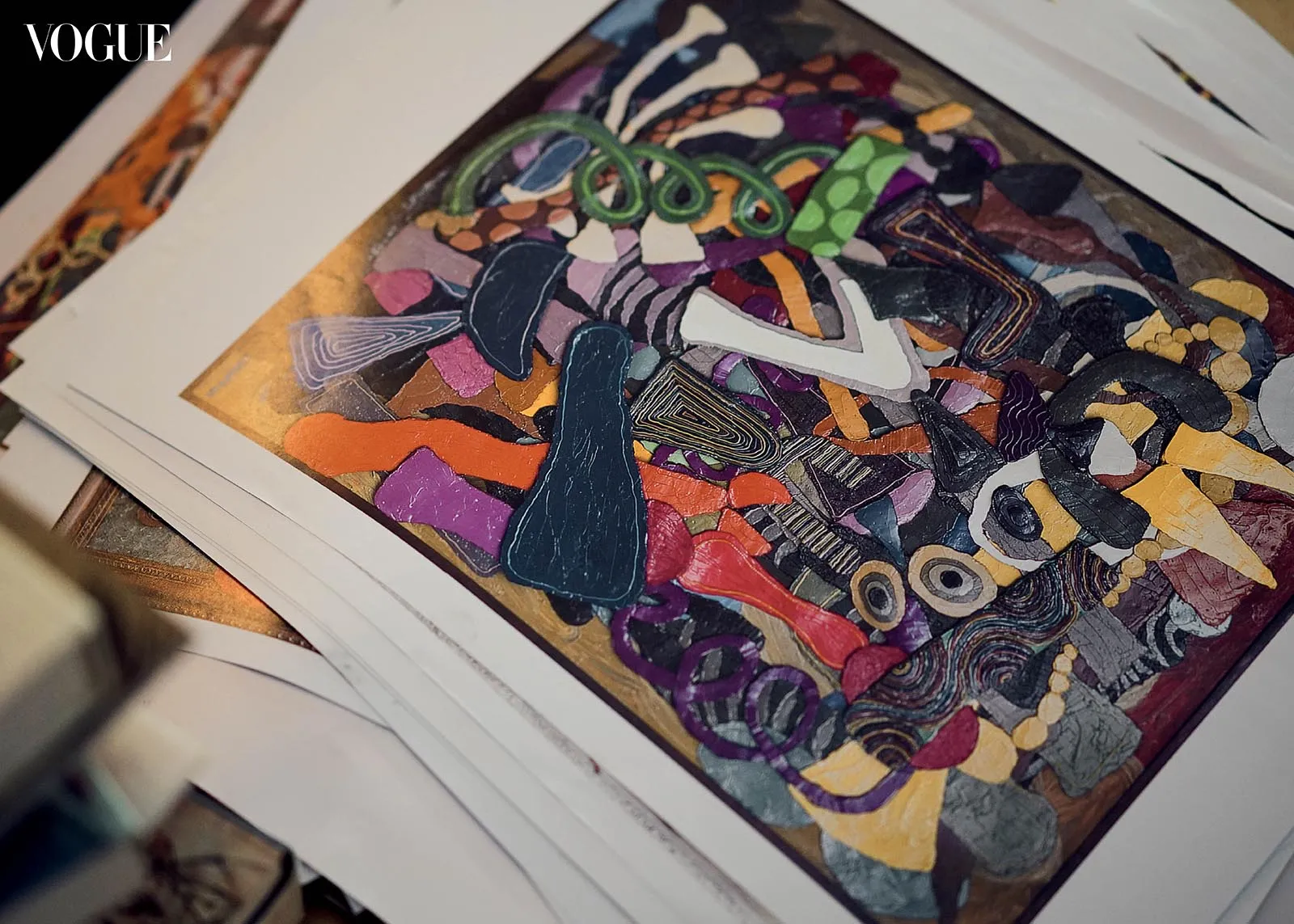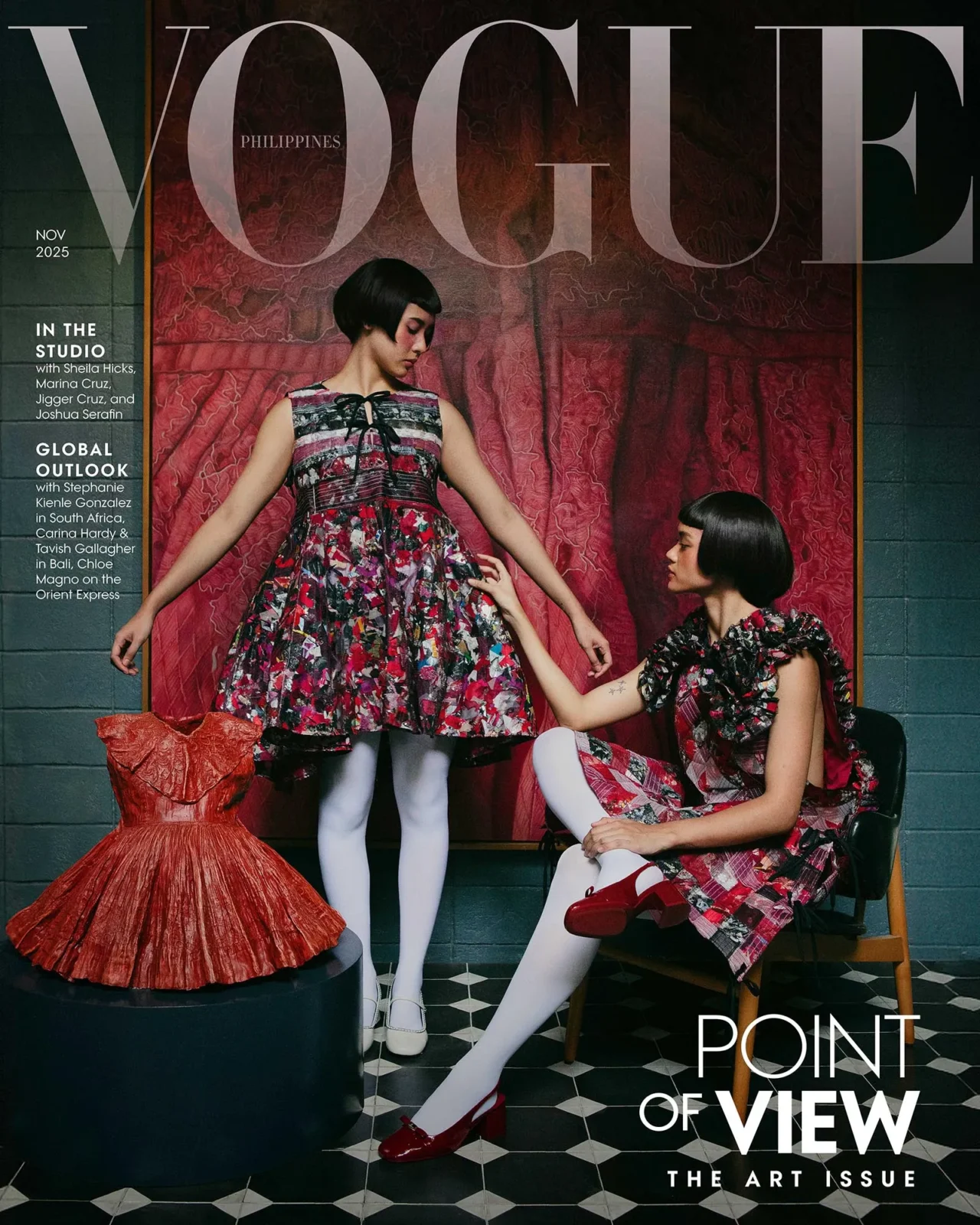Artist Jigger Cruz photographed in his home studio. Photographed by Jason Quibilan for the November 2025 Issue of Vogue Philippines
Photographed by Jason Quibilan for the November 2025 Issue of Vogue Philippines
While rooted in destruction, the language of Jigger Cruz’s art has evolved, constantly pushing him to create something new.
“Welcome to the Jigger Cruz Band,” deadpans Ely Buendia after he got the crowd chorusing to “Ang Huling El Bimbo.” Jigger Cruz celebrated on the eve of his 41st birthday, and we all pressed close to the stage. Buendia, one of the most popular frontmen in Filipino music, had just sung three of his greatest hits. “We’ve made this a tradition,” he continues. “We’re here for every Jigger birthday.” After midnight, it was Rico Blanco’s turn on stage. Throughout it all, Cruz remained in the background, steady on the drums, accompanying each performer like he always has.
Cruz had us all Googling directions to a speakeasy tucked inside one of Makati’s side streets. A mix of fellow artists, art collectors, musicians, filmmakers, a smattering of politicians, made up the crowd. It was a fun, cool, exclusive group, devoid of flash despite the personalities present, a testament to the pull of the artist.
Fourteen years ago, in 2011, I interviewed the then 27-year-old Cruz as he prepared for his first group show in Milan. At that time, he had just gotten on the radar of Manila’s art collectors.
Even then, a drum set stood to one side of his Fairview studio. He admitted to spending more time pounding out rhythms than on his art, despite the surging demand for his vibrant “Destructions” series of paintings.

A week after the party, we walk into his studio, and the first thing that greets us is another set of drums, larger than what I remembered from his rented space. Vogue Philippines is here to shoot Cruz as he prepares for Hail Holy Eyes, set to open later this month at the Metropolitan Museum of Manila. The exhibition features more than 50 paintings, a sound installation, and a collection of new sculptures, including a seven-foot tall piece carved from limestone in the Cordilleras.
The studio is what you would expect of a superstar artist. He works between two structures, separated by a pool, to complete several cavernous paintings in progress. Along one side of the water, more than half a dozen gleaming big bikes stand in a row. Tubes of paint, seemingly more than a hundred, cram the shelves of the warehouse-like studio at the back of the property. You move around a mound of used tubes heaped as high as his assistant’s waist. In the main house, two tables overflow with synthesizers and drum machines. An assortment of polychrome statuary called buntis, carvings of bell-shaped Blessed Virgins, rest on an elaborate commode, all prized antiques from Bohol. A python curls up inside a long glass aquarium. This space obviously doubles as a party venue. An indoor bar and bar carts stacked with bottles of whisky, wine, and tequila, stand ready to host the same circle of friends who gathered for his birthday.
“The act of destroying the works is Jigger’s way of making himself part of the story.”
The trappings of success rest easy on Cruz, primarily because it allows him to provide for his family. He lives five minutes from his studio with his fiancée, Aira Hernandez, and two young daughters, ages five and three.
“I try to paint in the daytime now,” Cruz says. “Otherwise, how will I see the kids?” Notoriously plagued by insomnia, he would work into the morning. “Lately, painting comes to me like breathing, something that simply is a part of my day. For years, I obsessed over details, trying to fit in the theories of art history in my work. Until I saw my daughter just pick up a brush without thinking. When I decided to paint like her, I found freedom.”
While the language has evolved, the essence of Cruz’s process remains rooted in destruction. He often begins with old master paintings, academic pieces, as foregrounds for his canvases. After completing them, he obliterates them. He layers on pigment in dense, tactile ways, thick blobs squeezed directly from tubes, paint piped onto the surface like icing, or slathered and dragged with a palette knife until it hardens into relief. In their latest incarnations, the works verge on wall-bound sculpture.
“The act of destroying the works is Jigger’s way of making himself part of the story.

That’s his way of inserting himself into history,” observes artist Manuel Ocampo. Cruz started many years ago as his assistant, and the two remain close friends. “Contrary to his soft-spoken nature, Jigger’s works are very violent: the gestures, the strong movement, the thickly applied paint.”
“I grew up in Malabon,” shares Cruz. “Dikit-dikit kami,” he explains his horror vacui. This Malabon energy, as he calls it, continues to course into his work. “You know, everything mixed up, the unsophisticated combination of colors?” The cacophony of living cheek by jowl explains the constant presence of thumping music in his environs. His studio equipment allows him to shape sound as he does his art. Silence doesn’t have a place in his universe. He works by jumping from one art piece to another, composing music in between. The art forms blend into one body of work, all outlets for creativity.
Efforts that hint at a new series of paintings stand in the studio too. “I’ve missed just using a paintbrush,” Cruz says before a painting distinct for its relative simplicity compared to the other works slated for The Met. “I decided to attempt old-school abstraction.” For another group of works, he reverses his process. “Usually, I cover the figurative with the abstract. For these ones here, I layered the paint first, then I am trying to paint details over them.” He shrugs when talk of his auction prices come up. “Yes, the auctions validated me. But I realized I’m too young to be corrupted by that. So I always have to challenge myself to be a good artist, to always create something new.”

Paying it forward is also an ethos. Fellow artists and close friends all speak of his generosity. “He let me live in his studio for seven years,” relates Bjorn Calleja. “I closed my design studio and had to start teaching. Jigger asked me what I thought I was doing? ‘You’re a painter. You need to just keep painting!’”
“I keep at this to impress them,” states Cruz, meaning his coterie of artist peers that include both Ocampo and Calleja. “They won’t bullshit me. Manuel especially, will always push me. ‘Pang market ba yan?” he’ll say when he doesn’t like my work.”
The exhibit at the Met promises to showcase the different stages in his career. Norman Crisologo, art collector, impresario, and another close friend, will curate the exhibition. “A decade ago, Norman gave me the confidence to keep going. He saw something in my work, and after all these years, he knows my work inside out.”
“The only thing I can do in my life is to create art,” Cruz reflects. There have been triumphs but there have also been heartaches. The art market is a cruel barometer, something he has learned to tune out. “If it were up to the market, to some galleries, they would keep me churning out the same things that sell. They just want to keep seeing work that I’m known for. Lucky for me, I can ignore that. I always keep in mind what Manuel Ocampo told me early on: identity is the death of an artist.”
By TRICKIE LOPA. Photographs by JASON QUIBILAN. Fashion Editor: David Milan. Producer: Bianca Zaragoza. Grooming: Christian Ray Arapoc. Photography Assistants: Arvin Somera and Jayson Reyes.
- Less Champagne, Less Fried Chicken: Expect ‘Simpler Work’ at Jigger Cruz’s Art Fair Philippines 2024 Exhibit
- Apocalypse Now: Inside Geraldine Javier’s Work at Alt Fair Philippines 2024
- Celine Lee On The Thread That Connects Science And Mathematics To Art
- Manny Garibay Wants His Audience to Reexamine Their Beliefs

